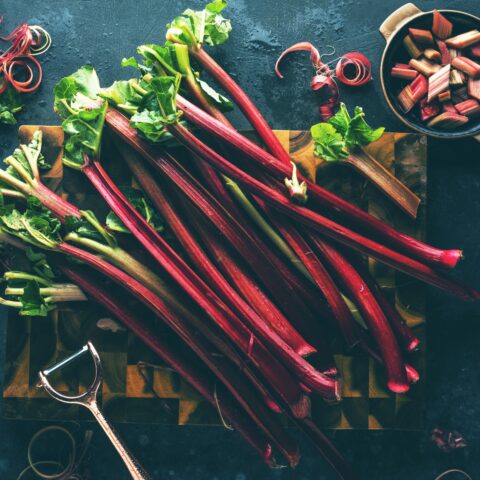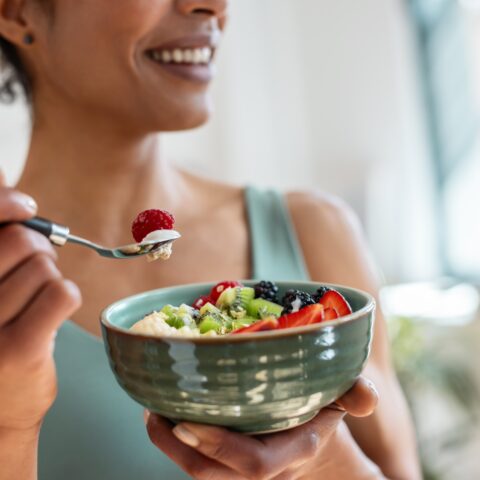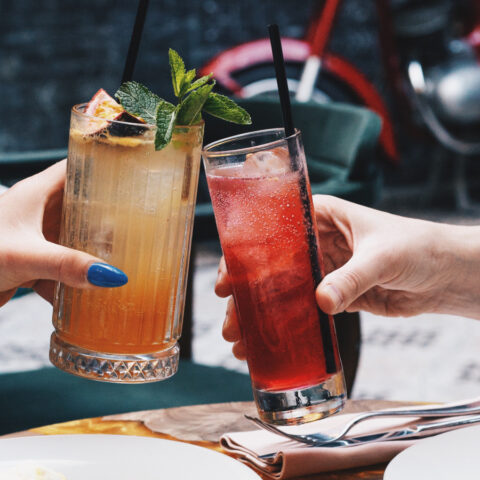Stomach Upset? Try This Gentle Paleo BRAT Diet Alternative

The BRAT diet (which stands for bananas, rice, applesauce, and toast) used to be the first thing recommended for an upset stomach. But we know that grains are unhealthy and applesauce is usually made with added sugar, so what’s a better substitute? Let’s take a look at why the BRAT diet is actually hard on your digestive tract and consider a Paleo BRAT diet alternative that is more gentle and healing for your stomach and gut.
When you have a sick child with an upset tummy and diarrhea (known to the medical community as gastroenteritis), it can be scary. Symptoms may include vomiting with or without diarrhea, lethargy, lightheadedness, cramping, and fever. It’s something to take seriously, because if severe dehydration occurs, it can (in rare occasions) be lethal. This inflammation of the digestive tract may be viral, bacterial, or even a reaction caused by food poisoning. [1]
While the BRAT diet is still sometimes recommended to parents, many experts suggest it is outdated. The American Academy of Pediatrics (AAP) now states that the BRAT diet is too restrictive and that most children can continue to eat a normal diet while they have mild diarrhea. [2]
The next time you kids experience a upset stomach, skip the saltine crackers and glass of ginger ale for healthier, nutrient dense, easier-to-digest foods instead. Read on to see what they are.
Problems with the BRAT diet
Beyond being too restrictive, the American Academy of Pediatrics says the BRAT diet lacks nutrients that help the gut lining heal. Any bland diet tends to be low in fiber, protein, and fat, which are needed for healing as well as satiety. A diet based only on bananas, apple sauce, and white foods (rice and toast) are definitely low in those healing nutrients.
Beyond the lack of macronutrients, the BRAT diet also contains rice and wheat, which are grains and not eaten on The Paleo Diet. Plus, saltine crackers are made with soybean oil, high fructose corn syrup, and partially hydrogenated cottonseed oil. These ingredients are inflammatory and definitely not Paleo-approved.
A Paleo BRAT Diet Alternative
Children and adults can safely follow The Paleo Diet® even during times of illness. Compared to the BRAT diet, The Paleo Diet offers more immune-boosting nutrients that encourage healing. The Paleo Diet also avoids inflammation-causing foods, like wheat and sugar, which may prolong irritation of the stomach and gut lining, potentially prolonging illness.
Here are some Paleo-friendly tips and food ideas to help him or her (or even you!) feel better soon.
What to Drink
Hydration should be your number one concern. Whenever there’s diarrhea or vomiting, it’s critical to replace lost body fluids immediately, with small sips of water every 5-15 minutes. [3] Ready to try something more plain water? Try these three suggestions!
1. Electrolyte drinks
Electrolyte sports beverages are often used during illness to maintain hydration, though the vast majority of these aren’t even close to Paleo. Most commercially produced sports drinks are highly processed, and contain toxic brominated vegetable oils, [4] refined sugars, sodium, and artificial food colorings.
If you prefer using an electrolyte replacement drink, opt for one that is entirely natural, organic, and free of added sugars. To go completely natural, consider drinking the water directly from a fresh, young coconut. Coconut water is often used for patients with gastroenteritis, as it is just as effective as carbohydrate-electrolyte beverages in rehydration, but with significantly less nausea and stomach upset. [5, 6, 7]
For more Paleo Diet-approved electrolyte drink ideas, read The 10 Best Natural Electrolyte Drinks for Everyday Hydration.
2. Herbal tea
Rather than reaching for ginger ale or some other soda, try medicinal herbal teas, such as ginger, chamomile, peppermint, or fennel, which are safe for children. [8] They have been traditionally used for their antispasmodic effects, ability to delay intestinal transit, and calming effect on gut motility. [9]
3. Bone broth
Homemade Paleo bone broth, which is easy to sip from a mug, also supports rehydration and contains key nutrients that are essential for maintaining a healthy digestive tract: gelatin, minerals, and amino acids, including anti-inflammatory glycine and proline. One nourishing and satiating recipe to try is this Avocado Coconut Bone Broth Frappe.
Slowly reintroduce solid food, once liquids have proven well tolerated, beginning with very small amounts of easy-to-digest foods to aid in efficient and speedy recovery. [10]
What to Eat
Skip the bland foods when you’re feeling sick. When you’re ready for something solid, these nutrient-dense foods are great options to help get you back on your feet.
1. Plantains
Plantains are similar to bananas, but pack more of a nutritional punch as they contain more vitamin A, C, zinc, magnesium and potassium. [11] Green plantains have more starch and less sugar than the very ripe (yellow or black) ones.
Unlike bananas, plantains need to be cooked. Try frying them in coconut oil, either thinly sliced to make them crispy, or thicker, which makes them taste like a sweeter white potato.
You can also try plantains dried and pulverized into a flour. When mixed with water and salt (sodium chloride), it is an effective rehydration drink. The plantain flour takes the place of glucose and is comparable to a traditional oral rehydration solution (ORS) [12, 13]
2. Squash
One cup of butternut squash provides 437% of the daily requirement for vitamin A, often depleted by diarrhea. [14] In addition to having more potassium than a banana, it also provides vitamins C, B-6 and E, thiamin, niacin, folate, pantothenic acid, magnesium and manganese. [15] Any winter squash, like butternut, acorn, or kabocha, can be steamed, baked or mashed.
3. Scrambled eggs or poultry
Lower fat animal proteins tend to be more appealing to sensitive stomachs while reintroducing solids. Scrambled eggs, ground turkey, and poached or baked chicken are a few simple choices to provide protein when transitioning back to a normal diet. Baked fish is also a good choice.
Note: In the event that vomiting or diarrhea lasts longer than a day, you can’t replace fluids faster than they are lost, or symptoms are more serious, it is important to seek professional medical care as soon as possible.
References
[1] LeBaron, Charles W., et al. (1990). “Viral agents of gastroenteritis. Public health importance and outbreak management,” MMWR. Recommendations and reports: Morbidity and mortality weekly report. Recommendations and reports/Centers for Disease Control, 39(RR-5), 1-24.
[2] Churgay, C. A., & Aftab, Z. (2012). Gastroenteritis in children: Part II. Prevention and management. American family physician, 85(11), 1066–1070.
[3] King, C. K., Glass, R., Bresee, J. S., Duggan, C., & Centers for Disease Control and Prevention (2003). Managing acute gastroenteritis among children: oral rehydration, maintenance, and nutritional therapy. MMWR. Recommendations and reports : Morbidity and mortality weekly report. Recommendations and reports, 52(RR-16), 1–16.
[4] Munro, I. C., Hand, B., Middleton, E. J., Heggtveit, H. A., & Grice, H. C. (1972). Toxic effects of brominated vegetable oils in rats. Toxicology and applied pharmacology, 22(3), 423–429.
[5] Campbell-Falck, Darilyn, et al. (2000). “The intravenous use of coconut water.” The American journal of emergency medicine 18(1), 108-111.
[6] Kuberski, T., et al. (1979). “Coconut water as a rehydration fluid.” The New Zealand medical journal, 90(641), 98-100.
[7] Saat, Mohamed, et al. (2002). “Rehydration after exercise with fresh young coconut water, carbohydrate-electrolyte beverage and plain water.” Journal of physiological anthropology and applied human science, 21(2), 93-104.
[8] Fugh-Berman A. (2002). Herbal Supplements: Indications, Clinical Concerns, and Safety. Nutrition today, 37(3), 122–124.
[9] Palombo, Enzo A. (2006). “Phytochemicals from traditional medicinal plants used in the treatment of diarrhoea: modes of action and effects on intestinal function.”Phytotherapy Research, 20(9), 717-724.
[10] Boxman, Ingeborg LA, et al. (2007). “An efficient and rapid method for recovery of norovirus from food associated with outbreaks of gastroenteritis.” Journal of Food Protection®, 70(2), 504-508.
[11] Nutrition Data. (2018). Plantain, Cooked: Nutrition and Calories. Self Magazine. Available at: https://nutritiondata.self.com…. Accessed on July 1, 2022.
[12] Berna, C., Alcaraz, G. M., Botero, J. E. (2005). [Oral rehydration with a plantain flour-based solution precooked with standardized electrolytes], Biomedia, 25(1), 11-21. https://pubmed.ncbi.nlm.nih.go…;
[13] Arias, M. M., Alcaráz, G. M., Bernal, C., & González, G. (1997). Oral rehydration with a plantain flour-based solution in children dehydrated by acute diarrhea: a clinical trial. Acta paediatrica (Oslo, Norway: 1992), 86(10), 1047–1051. https://doi.org/10.1111/j.1651…;
[14] World Health Organization. (2005). The Treatment of Diarrhoea: A manual for physicians and other senior health workers. Available at: //whqlibdoc.who.int/publications/2005/9241593180.pdf.
[15] Nutrition Data. (2018). Squash, winter, butternut, cooked, baked, without salt. Self Magazine. Available at: Self Magazine. Accessed on July 1, 2022.
Betsy Schroeder
Betsy does research and writing for a few different websites in the natural health field after taking Masters level courses in Nutrition & Functional Medicine through the University of Western States.
More About The Author



